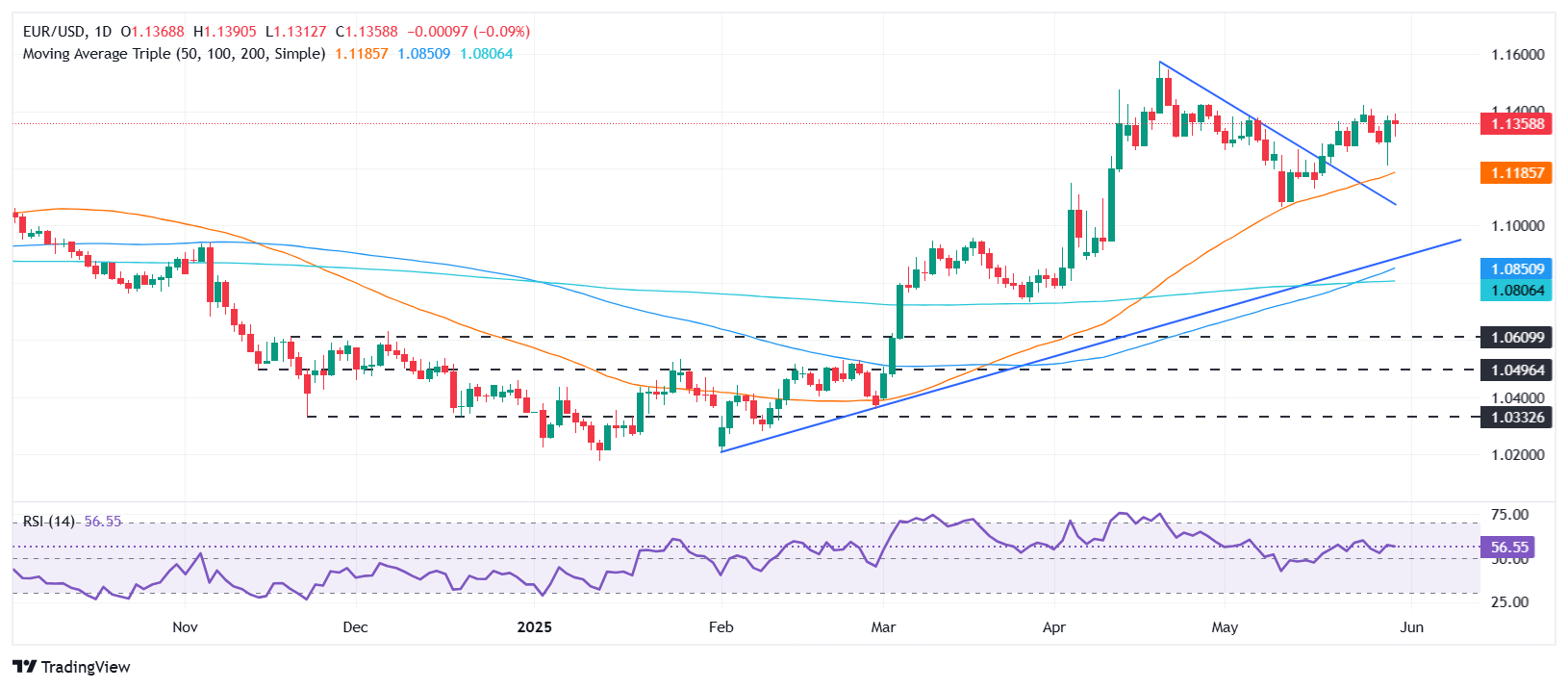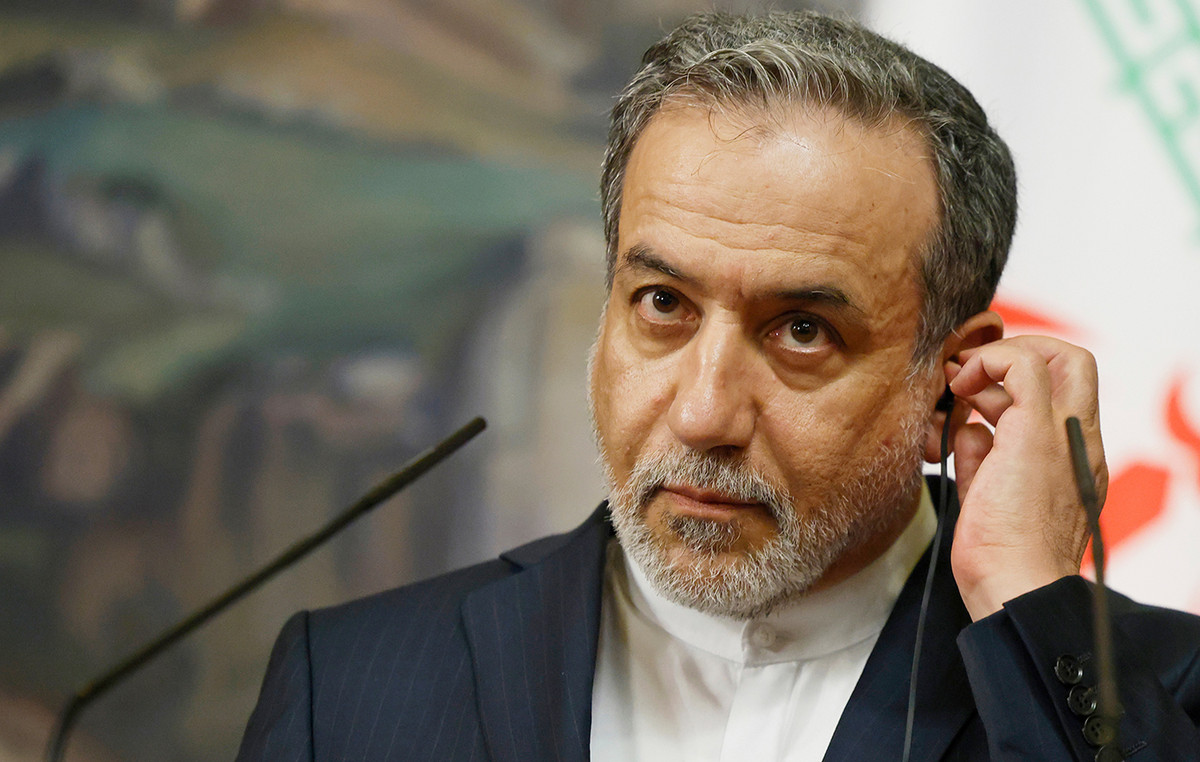- The EUR/USD is driven by a weaker American PCE, but underlying inflation remains persistent between 2% and 3%.
- Trump revives tensions with China, appeals the decision on tariffs; The trade of “selling America” gains traction.
- German retail sales collapse, while the probabilities of cutting ECB rates increase before the June 5 policy meeting.
The euro (EUR) remains stable against the US dollar (USD) on Friday after an American consumption spending price index (PCE) weakest than expected, which was close to the objective of 2% of the Federal Reserve (FED), which promoted the pair from minimum daily of 1,1312. The EUR/USD is quoted at 1,1361, practically unchanged in the day.
The mood on the market is still fragile, oscillating between optimism and pessimism, holding US actions due to tariffs and commercial news. The US International Trade Court ruled that the tariffs were illegal and ordered Washington to lift them within ten days. However, the Trump administration appealed the decision in a federal court, which restored most of the rights imposed on April 2, known as the “Day of Liberation.”
President Donald Trump caused a change in the feeling after stating that China is not committed to complying with the terms of the Switzerland agreement. However, he said he would talk to Chinese President Xi Jinping to accelerate negotiations between Washington and Beijing.
Apart from the commercial policy, the approval of the “Great Beautiful Project” of Trump, which is expected to add trillions of dollars to an already high fiscal deficit, keeps the operators inclined towards assets outside the US in the so -called trade of “selling America.”
As for the data, the US calendar revealed that the PCE figures are moving in the right direction, but not the inflation of the underlying PCE, which remained stagnant at the midpoint between 2% and 3%. Meanwhile, an improvement in the feeling of the consumer, as revealed by the University of Michigan (UOM), suggests that US households are slightly changing to optimism about the economy despite providing an increase in inflation.
On the other side of the Atlantic, German retail sales collapsed in monthly terms. Inflation in Germany and Spain remains within the limits of the 2% target of the European Central Bank (ECB), which could increase the possibilities of an ECB rates cut at the June 5 meeting.
EUR/USD daily market movements: progress stops in the recovery of the US dollar
- The American PCE rose 2.1% year -on -year, below the 2.3% increase in March. However, the preferred inflation measure of the Fed, the underlying PCE, reflected the evolution of the disinflation process, with a data of 2.5% year -on -year in April, lowering 2.6%.
- The feeling of the UOM consumer in May improved from 50.8 to 52.2, exceeding estimates in its final reading. It should be noted that inflation expectations fell. For the next 12 months, expectations fell from 7.3% to 6.6%, and for the next five years, they fell from 4.6% to 4.2%.
- Federal Reserve officials stated on Thursday that monetary policy remains adequately positioned, noting that it will take time to evaluate changes in the balance of risks related to their dual mandate of maximum employment and price stability.
- German retail sales collapsed by -1.1% monthly in April, below the 0.9% increase in March and 0.2% estimates. Regarding inflation, the Harmonized Consumer Price Index (HICP) of May was 2.1% year -on -year, below April 2.2%, approaching the 2% objective of the ECB.
- The preliminary data of the HICP of Spain for May fell from 2.2% to 1.9% year -on -year, below the objective of the ECB.
- The financial market participants had completely valued the expectation that the ECB would reduce their deposit installation rate by 25 basic points (PBS) to 2% in the next monetary policy meeting.
EUR/USD technical perspective: around 1,1350 without address is maintained
The EUR/USD still has an upward trend, but the trend has stopped before the weekend. The bulls seem to have lost some impulse due to the lack of conquest of the figure of 1.14, which could have taken prices to challenge the maximum of April 22, 1,1547, before the peak of the year to date (YTD) of 1,1572.
Although the relative force index (RSI) indicates that buyers are in control, the RSI is falling, prepared to reach a lower minimum below its neutral 50 line.
Therefore, if the EUR/USD achieves a daily closure below 1,1350, the torque could be diverted to 1,1300. In case of greater weakness, the next support level will be the simple mobile average (SMA) of 20 days in 1,1272, followed by the 50 -day SMA in 1,1193.

Euro Faqs
The euro is the currency of the 19 countries of the European Union that belong to the Eurozone. It is the second most negotiated currency in the world, behind the US dollar. In 2022, it represented 31 % of all foreign exchange transactions, with an average daily business volume of more than 2.2 billion dollars a day. The EUR/USD is the most negotiated currency pair in the world, with an estimate of 30 %of all transactions, followed by the EUR/JPY (4 %), the EUR/GBP (3 %) and the EUR/AU (2 %).
The European Central Bank (ECB), based in Frankfurt (Germany), is the Eurozone reserve bank. The ECB establishes interest rates and manages monetary policy. The main mandate of the ECB is to maintain price stability, which means controlling inflation or stimulating growth. Its main tool is the rise or decrease in interest rates. Relatively high interest rates (or the expectation of higher types) usually benefit the euro and vice versa. The GOVERNMENT BOOK of the ECB makes decisions about monetary policy in meetings that are held eight times a year. The decisions are made by the directors of the National Banks of the Eurozone and six permanent members, including the president of the ECB, Christine Lagarde.
Eurozone inflation data, measured by the harmonized consumer prices index (IPCA), are an important economic indicator for the euro. If inflation increases more than expected, especially if it exceeds 2% of the ECB, it forces the ECB to rise interest rates to control it again. Relatively high interest rates compared to their counterparts usually benefit the euro, since they make the region more attractive as a place for global investors to deposit their money.
Published data measure the health of the economy and can have an impact on the euro. Indicators such as GDP, manufacturing and services PMIs, employment and consumer trust surveys can influence the direction of the single currency. A strong economy is good for the euro. Not only attracts more foreign investment, but it can encourage the ECB to raise interest rates, which will directly strengthen the euro. Otherwise, if economic data is weak, the euro is likely to fall. The economic data of the four largest economies in the euro zone (Germany, France, Italy and Spain) are especially significant, since they represent 75% of the economy of the euro area.
Another important fact that is published on the euro is the commercial balance. This indicator measures the difference between what a country earns with its exports and what you spend on imports during a given period. If a country produces highly demanded export products, its currency will gain value simply by the additional demand created by foreign buyers seeking to buy those goods. Therefore, a positive net trade balance strengthens a currency and vice versa in the case of a negative balance
Source: Fx Street
I am Joshua Winder, a senior-level journalist and editor at World Stock Market. I specialize in covering news related to the stock market and economic trends. With more than 8 years of experience in this field, I have become an expert in financial reporting.





